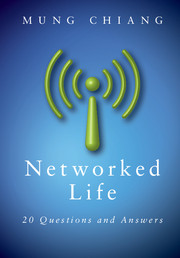Book contents
- Frontmatter
- Contents
- Preface
- Acknowledgements
- Roadmap
- 1 What makes CDMA work for my smartphone?
- 2 How does Google sell ad spaces?
- 3 How does Google rank webpages?
- 4 How does Netflix recommend movies?
- 5 When can I trust an average rating on Amazon?
- 6 Why does Wikipedia even work?
- 7 How do I viralize a YouTube video and tip a Groupon deal?
- 8 How do I influence people on Facebook and Twitter?
- 9 Can I really reach anyone in six steps?
- 10 Does the Internet have an Achilles' heel?
- 11 Why do AT&T and Verizon Wireless charge me $10 a GB?
- 12 How can I pay less for each GB?
- 13 How does traffic get through the Internet?
- 14 Why doesn't the Internet collapse under congestion?
- 15 How can Skype and Bit Torrent be free?
- 16 What's inside the cloud of iCloud?
- 17 IPTV and Netflix: How can the Internet support video?
- 18 Why is WiFi faster at home than at a hotspot?
- 19 Why am I getting only a few % of the advertised 4G speed?
- 20 Is it fair that my neighbor's iPad downloads faster?
- Index
- Notes
Preface
Published online by Cambridge University Press: 05 November 2012
- Frontmatter
- Contents
- Preface
- Acknowledgements
- Roadmap
- 1 What makes CDMA work for my smartphone?
- 2 How does Google sell ad spaces?
- 3 How does Google rank webpages?
- 4 How does Netflix recommend movies?
- 5 When can I trust an average rating on Amazon?
- 6 Why does Wikipedia even work?
- 7 How do I viralize a YouTube video and tip a Groupon deal?
- 8 How do I influence people on Facebook and Twitter?
- 9 Can I really reach anyone in six steps?
- 10 Does the Internet have an Achilles' heel?
- 11 Why do AT&T and Verizon Wireless charge me $10 a GB?
- 12 How can I pay less for each GB?
- 13 How does traffic get through the Internet?
- 14 Why doesn't the Internet collapse under congestion?
- 15 How can Skype and Bit Torrent be free?
- 16 What's inside the cloud of iCloud?
- 17 IPTV and Netflix: How can the Internet support video?
- 18 Why is WiFi faster at home than at a hotspot?
- 19 Why am I getting only a few % of the advertised 4G speed?
- 20 Is it fair that my neighbor's iPad downloads faster?
- Index
- Notes
Summary
You pick up your iPhone while waiting in line at a coffee shop. You Google a not-so-famous actor and get linked to a Wikipedia entry listing his recent movies and popular YouTube clips. You check out user reviews on IMDb and pick one, download that movie on BitTorrent or stream it in Netflix. But for some reason the WiFi logo on your phone is gone and you're on 3G. Video quality starts to degrade a little, but you don't know whether it's the video server getting crowded in the cloud or the Internet is congested somewhere. In any case, it costs you $10 per gigabyte, and you decide to stop watching the movie, and instead multitask between sending tweets and calling your friend on Skype, while songs stream from iCloud to your phone. You're happy with the call quality, but get a little irritated when you see that you have no new followers on Twitter.
You've got a typical networked life, an online networked life.
And you might wonder how all these technologies “kind of” work, and why sometimes they don't. Just flip through the table of contents of this book. It's a mixture: some of these questions have well-defined formulations and clear answers while for others there is still a significant gap between the theoretical models and actual practice; a few don't even have widely accepted problem statements. This book is about formulating and answering these 20 questions.
- Type
- Chapter
- Information
- Networked Life20 Questions and Answers, pp. ix - xiPublisher: Cambridge University PressPrint publication year: 2012



